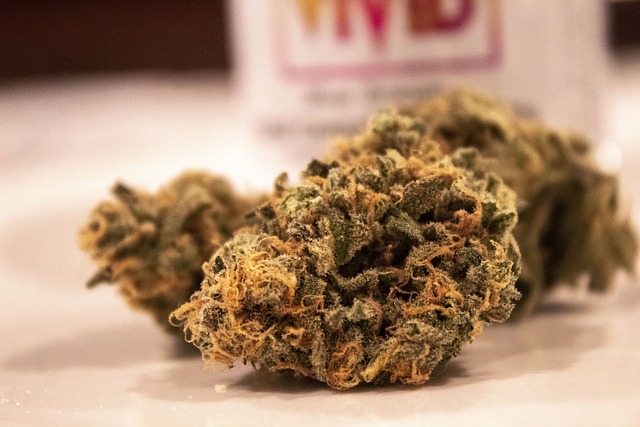THCA (tetrahydrocannabinolic acid) is a non-psychoactive cannabinoid found abundantly in raw Cannabis sativa plants, including hemp and many cannabis strains. It has been recognized for its therapeutic properties, such as anti-inflammatory, neuroprotective, and analgesic effects. These benefits stem from THCA’s interaction with the endocannabinoid system through CB1 and CB2 receptors. The entourage effect, a result of THCA’s synergy with other compounds like terpenes and flavonoids in the THCA flower, is believed to enhance these therapeutic effects. The interest in THCA flower has grown among those seeking health benefits associated with cannabis without psychoactive side effects, particularly for conditions like pain management, gastrointestinal issues, neuroprotection, and inflammation. While anecdotal evidence and some scientific research support these potential applications of THCA, comprehensive human clinical trials are still needed to fully elucidate its effects and benefits. The exploration of THCA flower’s therapeutic potential underscores its significance in the realm of cannabinoid-based therapies.
Exploring the multifaceted nature of THCA flower, this article delves into its potential health benefits and role in medical treatments, while also addressing its psychoactive properties and effects. From understanding the botanical origins to navigating legal considerations and the regulatory landscape, we provide a comprehensive overview of this cannabinoid-rich plant. As we examine the entourage effect and the importance of dosage and consumption methods for optimizing THCA flower’s efficacy and safety, readers will gain insight into how to source high-quality THCA flower responsibly. We also debunk myths, analyze clinical trials, and discuss real-life experiences to present a balanced view of the THCA flower’s effects and benefits. Join us as we explore the scientifically grounded aspects of THCA flower and CBD and its potential impact on well-being.
Understanding THCA Flower: A Botanical Overview

Cannabinoid compounds within the cannabis sativa plant, such as tetrahydrocannabinolic acid (THCA), have garnered significant attention for their potential effects and benefits. THCA is the precursor to THC, the psychoactive component of cannabis, but unlike THC, THCA exists naturally in hemp and many cannabis strains and does not induce psychoactive effects. It’s found abundantly in raw cannabis flowers and is known for its wide array of therapeutic properties. Research suggests that THCA interacts with the body’s endocannabinoid system, potentially offering anti-inflammatory, neuroprotective, and analgesic benefits without the psychotropic effects associated with THC.
The botanical profile of THCA flower is distinct; it contains a high concentration of this non-psychoactive cannabinoid, alongside other beneficial compounds such as terpenes and flavonoids, which contribute to its unique effects and benefits. These secondary metabolites not only enhance the entourage effect, amplifying the positive attributes of THCA, but also impart a diverse flavor and aroma profile. The therapeutic potential of THCA flower extends to various conditions, with anecdotal evidence and emerging scientific research supporting its use for pain management, gastrointestinal issues, neuroprotection, and as an anti-inflammatory agent. Users interested in the beneficial effects of cannabis without psychoactive influence often turn to THCA-rich products, highlighting the importance of this compound within the broader context of cannabinoid therapeutics.
The Science Behind THCA: Cannabinoid Basics

Delta-9-tetrahydrocannabinolic acid, commonly referred to as THCA, is one of the most prominent cannabinoids found in the Cannabis sativa plant. While well-known for its psychoactive counterpart, Delta-9-THC, when heated or decarboxylated, THCA exists in its non-psychoactive form and possesses a unique set of properties. Research suggests that THCA interacts with the body’s endocannabinoid system through its receptors, namely CB1 and CB2, influencing various physiological functions. This interaction is believed to underlie many of the potential effects and benefits associated with THCA flower consumption, including anti-inflammatory, neuroprotective, and potentially antiemetic properties.
The therapeutic potential of THCA flower is an area of growing scientific interest. Preclinical studies have indicated that THCA may exhibit analgesic effects, offering relief for pain management without the psychoactive high associated with THC. Additionally, its anti-inflammatory actions are thought to be beneficial for conditions like arthritis, and its neuroprotective qualities might contribute to the protection of neurons in neurodegenerative diseases. While human clinical trials are necessary to substantiate these findings, the foundational science behind THCA’s effects and benefits offers a promising avenue for future research into cannabinoid-based therapies.
In conclusion, the THCA flower holds a multifaceted role within the realm of cannabinoids, offering a spectrum of effects and benefits that continue to be explored. As outlined in our discussion, understanding the botanical composition and scientific properties of THCA is pivotal for comprehending its potential influence on health and well-being. While research is ongoing to fully elucidate its effects, preliminary studies suggest that THCA may provide therapeutic benefits without the psychoactive impact associated with other cannabinoids. Users are encouraged to approach THCA flower with caution, considering individual sensitivities and potential side effects, which can vary from mild to severe. It is always recommended to consult healthcare professionals before incorporating THCA flower into one’s wellness routine to ensure safe and informed usage.
